Key takeaways:
- Traditional forms can enhance or stifle creativity, leading artists to balance respect for conventions with personal expression.
- Challenges in breaking traditional forms include fear of judgment, risk of alienation, and misunderstandings from audiences.
- Innovative techniques like multimedia, improvisation, and collaboration can foster authenticity and personal connection in art.
- Embracing new approaches revitalizes creativity, expands audiences, and nurtures resilience through experimentation.
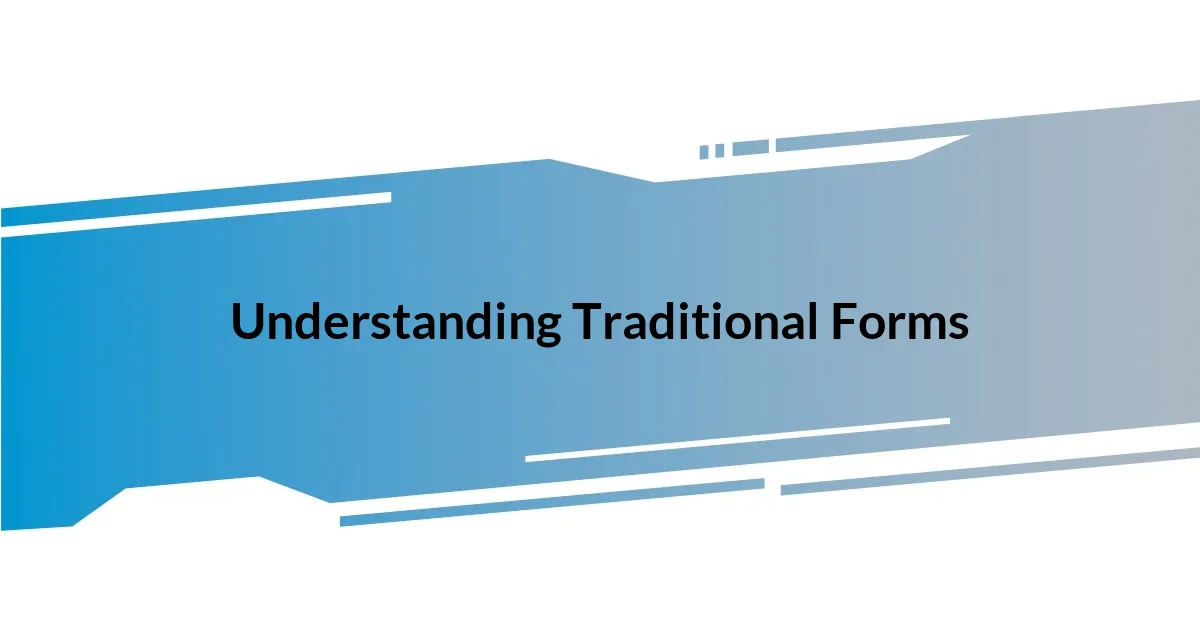
Understanding Traditional Forms
Traditional forms refer to established methods and structures, often rooted in historical, cultural, or artistic contexts. I’ve often felt the weight of these conventions, whether in literature, music, or even visual artistry. Have you ever found yourself locked into a rigid structure, feeling it stifles your creativity?
Consider the sonnet as an example—a well-defined poetic form that adheres to specific meter and rhyme schemes. There was a time when I meticulously followed these rules, but I discovered that my voice often felt muted under their constraints. It makes me wonder: can tradition enrich our expression, or does it sometimes feel like a chain?
When I speak with fellow artists, I see a mix of reverence and frustration towards these traditional forms. They provide a sense of guidance, yet there’s a yearning for freedom and personal voice. Isn’t it fascinating how many of us grapple with the tension between respecting the past and embracing our individuality?
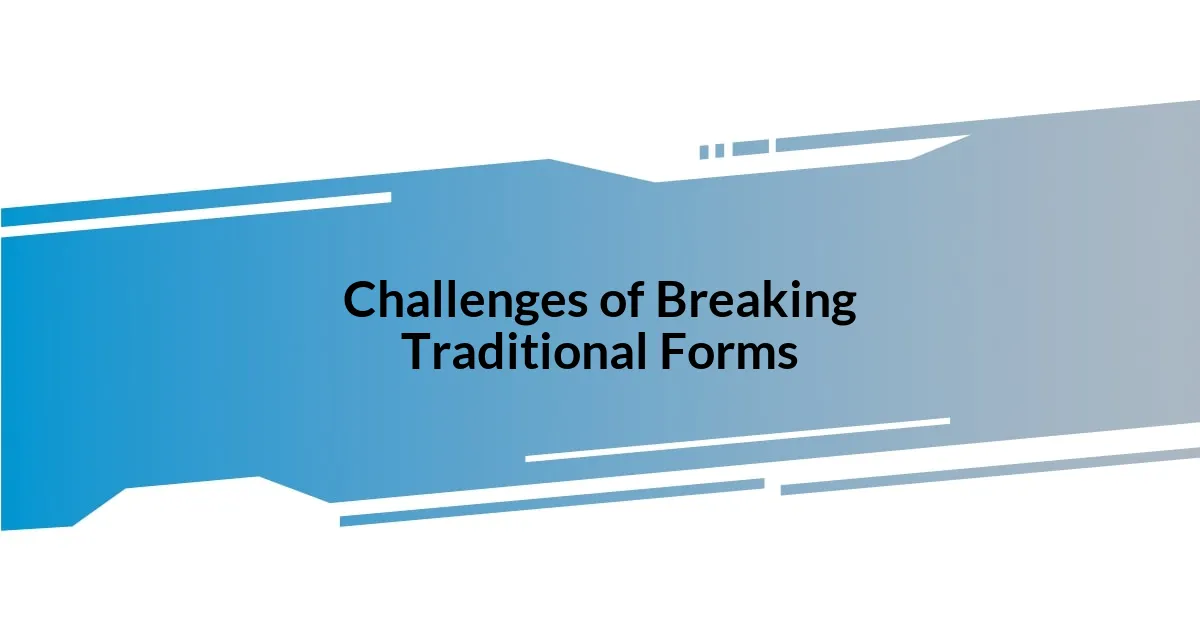
Challenges of Breaking Traditional Forms
Breaking traditional forms can be a daunting task. I remember the first time I attempted to write a free verse poem after years of sticking to traditional structures. It was exhilarating, yet terrifying. The challenge lies in overcoming the fear of judgment—both from ourselves and the audience. What happens if they don’t resonate with my interpretation of art? This internal struggle often holds creatives back, making them question their worth in a world that often favors the familiar.
Another significant challenge is the risk of alienation. Straying from established conventions can result in feelings of isolation from peers and critics alike. I’ve experienced moments where my experimental pieces were met with puzzled expressions instead of appreciation. Those experiences can be disheartening. The push for innovation must be balanced with the desire to connect, and finding that equilibrium is tricky.
It’s also essential to acknowledge that breaking traditional forms can lead to misunderstandings. When I shifted my approach in graphic design, some clients struggled to see the value in my new methods. They were comfortable with familiar layouts and styles. That moment illustrated the need for education and clarity when venturing into uncharted creative territories. The journey of breaking traditional forms is fraught with obstacles, but it’s also where the most significant growth occurs.
| Challenge | Description |
|---|---|
| Fear of Judgment | Confronting the anxiety of personal expression being scrutinized by others. |
| Risk of Alienation | Straying from tradition may lead to disconnection from peers and audiences. |
| Misunderstandings | New approaches can confuse those accustomed to conventional methods. |
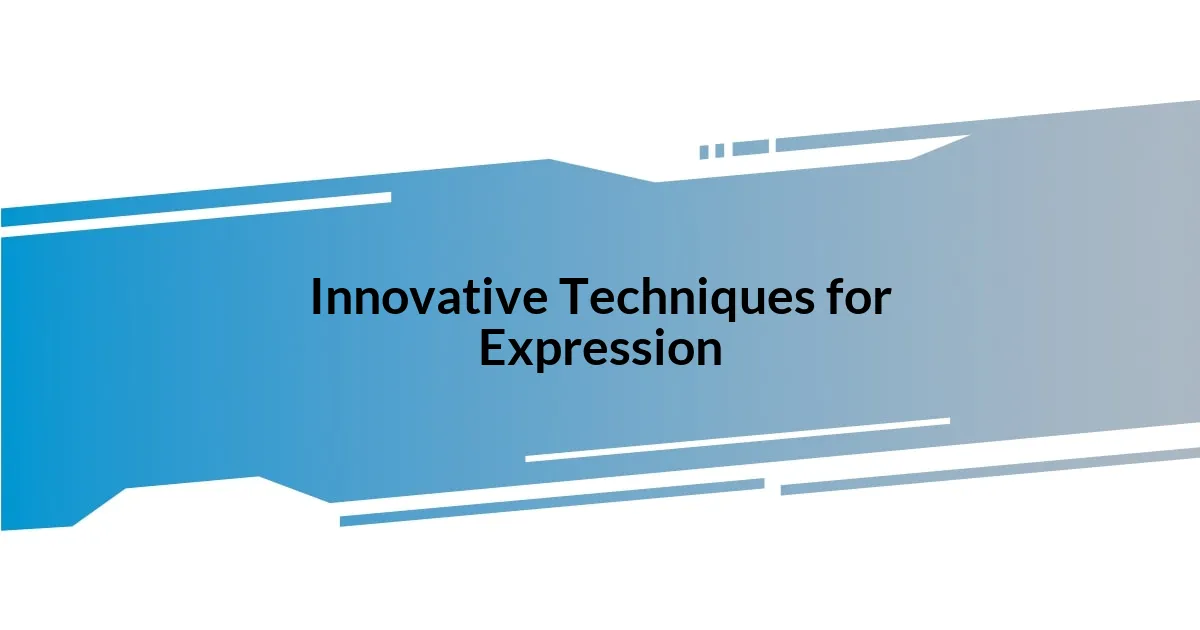
Innovative Techniques for Expression
Innovative techniques for expression are often born out of a desire to connect more deeply with one’s own authenticity. I recall experimenting with mixed media in my artwork and how liberating it felt to combine textures and colors in ways that traditional painting never allowed. The result was not just a visual experience, but an emotional narrative that reflected my unique journey. This fusion of different forms and materials can open new channels of creativity and reinvigorate artistic endeavors.
Here are some techniques that I find can inspire fresh perspectives:
- Multimedia Approaches: Combining video, sound, and traditional mediums creates a dynamic experience.
- Interactive Art: Inviting viewers to engage physically or intellectually encourages personal connections.
- Improvisation: Allowing spontaneity in performance—like a dance or a live music set—spurs innovation and reveals hidden talents.
- Collaborative Projects: Working with other artists can foster new ideas and push boundaries beyond your comfort zone.
- Digital Platforms: Utilizing social media or digital artwork can expand your reach and audience engagement.
These innovative techniques have the potential to break down barriers, ultimately enriching the creative process while allowing for a more personal expression.
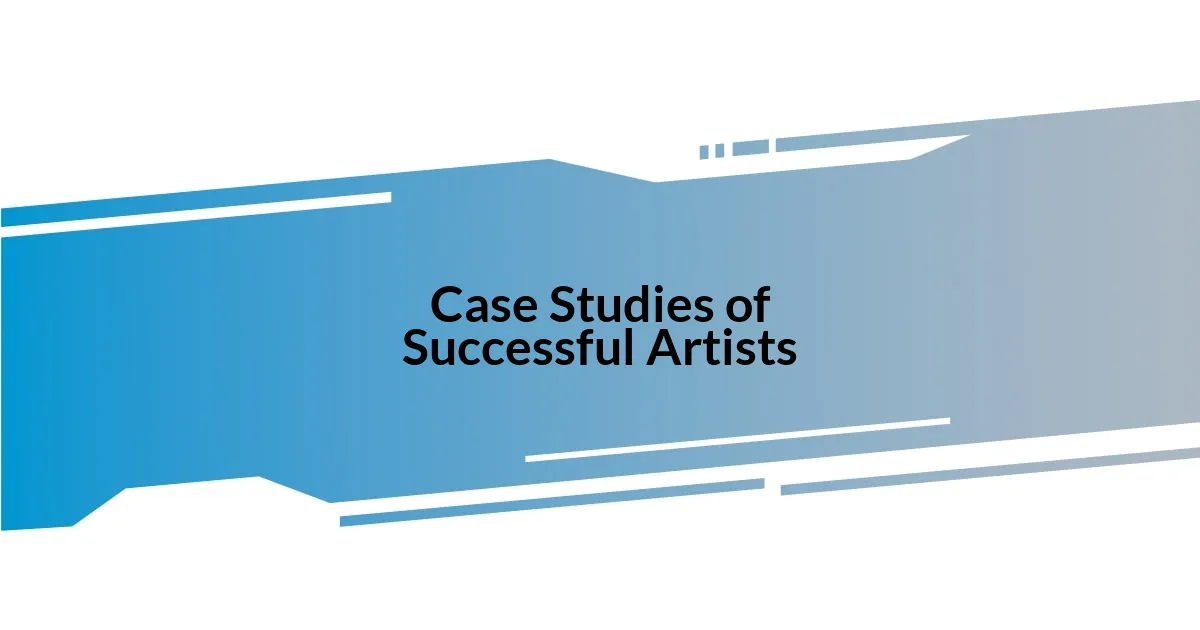
Case Studies of Successful Artists
When I think about successful artists who broke traditional forms, I can’t help but admire the boldness of musicians like David Bowie. He didn’t just defy genres; he created entirely new identities. I remember discovering his album “Ziggy Stardust” and how it felt like an invitation to embrace my quirks. Bowie’s artistry reminds me that breaking boundaries often brings forth new voices, allowing for an explosion of creativity that speaks to those who might feel out of place in the conventional arts.
Then there’s the renowned visual artist Banksy, who uses street art as a medium to challenge societal norms. I was struck by his piece “Girl with Balloon” and how it encapsulates hope amidst despair. The way he cleverly shares poignant messages in unexpected public spaces made me reflect—how many times have I overlooked the power of context in my own work? Banksy teaches us that art can thrive outside the traditional gallery walls, reaching broader audiences and sparking conversations that challenge the status quo.
Looking to literature, one cannot ignore the transformative approach of Toni Morrison. Her use of magical realism in novels like “Beloved” creates a space where history, memory, and fantasy intertwine. I found myself deeply moved as I read her work, realizing how breaking narrative forms can illuminate experiences that resonate on a profound level. Morrison’s stories invite us to embrace complexity and challenge how we define storytelling—she shows us that there’s beauty in experimenting with form and content.
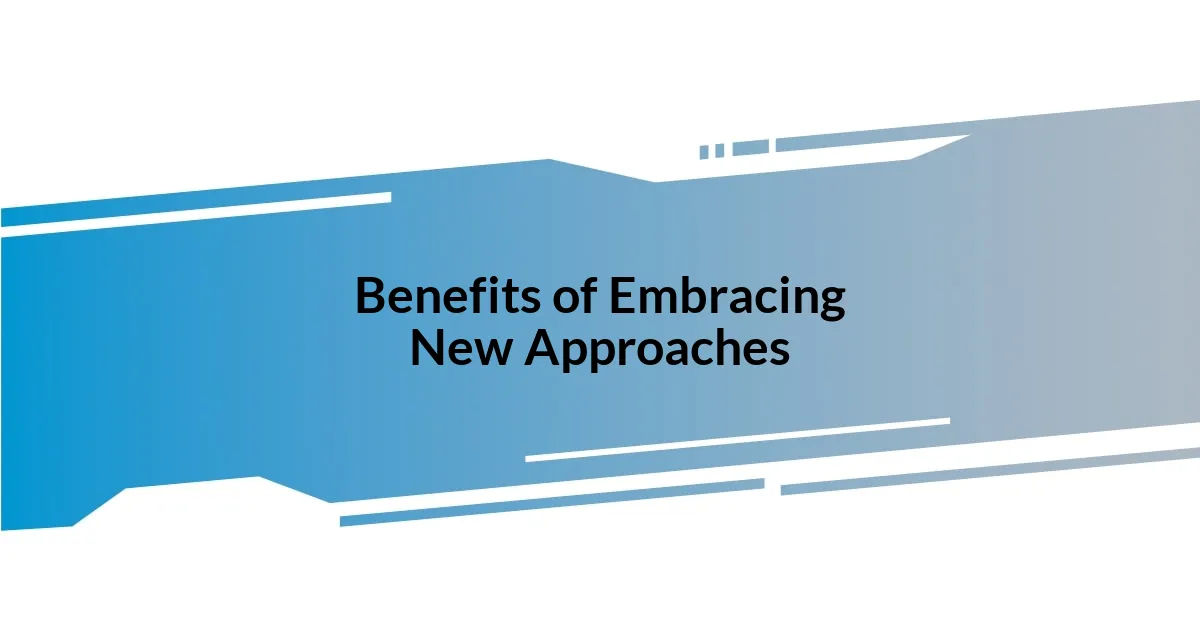
Benefits of Embracing New Approaches
Embracing new approaches offers a fresh lens through which we can view our creative pursuits. I remember the first time I decided to use digital tools to create a piece of artwork. It felt exhilarating to enhance my work with layers and effects that were impossible with traditional methods. This shift not only expanded my skills but invigorated my artistic expression, breathing new life into concepts I thought had run their course.
Another substantial benefit is the opportunity to connect with diverse audiences. When I began sharing my work online, I was amazed at the instant feedback I received from people around the world. It truly opened my eyes to the power of community in art. Collaborating with artists from different backgrounds led to a rich exchange of ideas, showcasing that diversifying our methods can lead to unexpected and beautiful results. Have I ever thought about how many voices are out there waiting to be heard? Absolutely, and it’s a realization that pushes me to keep evolving.
Most significantly, embracing new methodologies nurtures resilience. I’ve faced moments of artistic block where traditional practices felt limiting. However, when I shifted my focus to experimenting with poetry and soundscapes, I discovered new ways to express emotions that words alone couldn’t capture. It made me appreciate the beauty in trial and error. The process taught me that creatively stretching beyond established boundaries can unlock parts of ourselves we didn’t even know existed. How liberating it is to know that each new method might lead me to an unexpected revelation!
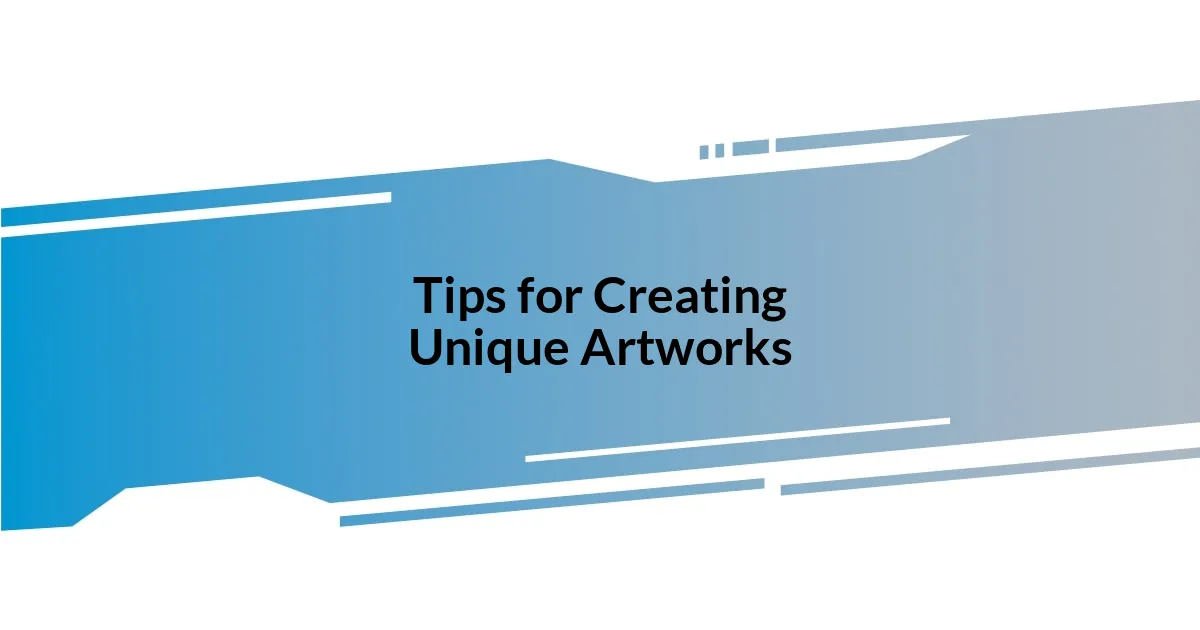
Tips for Creating Unique Artworks
When I’m in the studio brainstorming ideas, I find it incredibly helpful to break away from conventional routines. One of my go-to tips is to change my environment—sometimes just a different room or even a cozy café sparks inspiration in unexpected ways. Have you ever noticed how a new setting can shift your perspective? For me, a simple walk in nature often leads to innovative thoughts that I’d never encounter in my usual workspace.
Another tactic is to embrace randomness in your creative process. I often print out random images or phrases from magazines and let them guide me. This playful approach not only alleviates pressure but also opens up fascinating avenues I hadn’t considered before. Just the other day, a mismatched color scheme in a magazine caught my attention, and it inspired an entire series of pieces bursting with vibrant, unconventional hues. Isn’t it funny how something so unrelated can ignite creativity?
Lastly, I believe collaboration is a unique conduit for originality. I try to partner with artists from disciplines outside my own—such as a dancer or a musician—and blend our styles. I remember working with a sculptor who used unconventional materials, like recycled plastics. Watching her transform discarded items into stunning pieces made me rethink the potential of my own mediums. It’s truly magical how a shared vision can push boundaries and forge something completely new. What have I learned from this? Sometimes, the best art comes from the melding of different worlds.